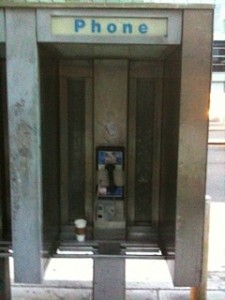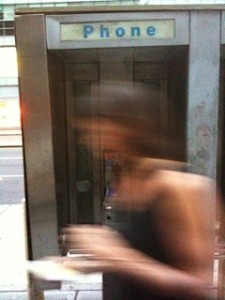The purpose of this project is to ferry the payphone into an afterlife of image and word before it disappears like a tribe without a written language under the bulldozer of modernity.*
What Kerouac said about the sadness of bus-station floors applies equally well to payphones. Their stoicism, their patient, heroic suffering, what we associate with saints, these are the things that make them beautiful. I imagine them as aged Broadway matrons, albums full of clippings clasped to their bosoms, waiting on the corners for someone to remember them. (I am their Billy Wilder; I have come to give them their close-up.) Or as worm-eaten prostitutes, caressed as smooth as driftwood, cast up onto the streets where they used to solicit, petrified there. Or abandoned dogs tied to lampposts, waiting for their master, any master, to come with kind word, let them drink from cupped hands. Or protestors, trapped in a generations-long act of civil disobedience; when the workers come to carry them away, the steel will suddenly turn to rubber. Or the Greeks at Thermopylae, making a last stand against the invincible future. In all these ways, they speak to every New Yorker, whose identity depends on the fantasy of living in that older, greater New York that directly preceded his or her arrival.
Lift the receiver; not even a dial tone. But isn’t the gnawed plastic still warm from the last hand that touched it, a hand just like yours? Why do you stick your finger where a thousand other fingers have been, noodling around in there for some stray nickel like a loose tooth? And what about the beer bottles and take-out containers they wear like uneasy crowns? The smell of urine, the fingerprints of a runaway, the old calling card left by a tourist rearranging the contents of his wallet, the used condom in a mound of soiled snow, the empty baggie, the stickers and graffiti—all the traces of those who have taken advantage of a moment’s shelter underneath that metal wimple …
And the stories, of course. Millions of them. Payphones like open-air confessionals. No acts of contrition required.
Have you never told your stories to the dead silence of a broken payphone? Try it. Go ahead. Lift the receiver, cradle it on your shoulder. Listen to the silence that, unlike the silence around you, assumes the shape of a void. The wire goes nowhere and everywhere, is connected to nothing and everything, as relatively primitive as the cup-and-string you played with as a child. There, you’re a child again. Go ahead. Whisper your deepest secrets. Your most obscure and embarrassing fantasies. The names of your secret loves. Hexes against those who caused you pain. The names of people you believe you could kill … or at least whose absence from the world would help tilt its moral ledger a hair nearer the black. Who knows but that somewhere in that gizzard full of coins, many of which are older than you, some fabulous organ hasn’t captured every word everyone has ever said there? If just one payphone could be coaxed out of its decades-long silence, ah, what sordid marvels …
Beautiful, too, that no one sees them anymore. But then part of the purpose of this project is to make us start seeing payphones, as the sticker on the bumpers of cars driven by motorcycle enthusiasts urges, and to say that, by paying attention to payphones, we are seeing the vestiges of a city that is daily more easy to ignore. The phone is a figure for this superannuated city, for vanishing public/collective space, for the people thrust from consciousness. Forgotten city, diminished city, residue-of-a-city. For a city depends on public space and public personhood in order to be a city; without these, it is something else—call it what you like—but it is not—it is not a city.
The ostensible replacement for the payphone—I mean the cell—is not a city-friendly technology. “Cell” better describes the person than the technology: each his or her own closed entity, milling about in proximity to but divided from every other. Of course, this is not a bad description of the pre-cell city, and one could argue that the cell consummates the city even as it dissolves it, that the cell simply further exacerbates the alienation that has been one consequence of technology, at once joining us and transforming our relationships and interactions. To argue that the cell represents some break with the past is thus to participate in a cell-induced myopia.
But then this is precisely what I am arguing: that the cell doesn’t simply exacerbate, but rather creates a whole new set of conditions for this alienation. For what the payphone could never do was really make us believe that we had “reach[ed] out and touch[ed] someone”—that is, give us a convincing illusion of wholeness. Historically, the city drew people with the fantasy of an achievable wholeness, which began by making them recognize, or imagine, their own lack thereof. What people found when they arrived was never that promised wholeness, but a desire that, in the multiple channels available for its fulfillment, sometimes masqueraded as wholeness … or at least enabled them to forget, for a time, what (or rather that) they lacked. The important thing was the awakening and cultivating of that desire. In the city you could have it all, or die trying; one day mouthing at the ineffable, unable to bite down; the next waking up in an alley, at the bottom of a river, on an out-of-service train. The payphone was never more than a go-between, a pulse on a wire: the tryst, the trick, the shady deal, the drop-off, the fugitive on the lam. If you went to the payphone to call home, it was only to be reminded of what you had lost, what you could never go back to. The payphone spoke the desire to connect, the endless deferral of that connection, and the palpability of loss.
The cell trades on a similar fantasy, but addreses it differently. On our fabulous little pocket phalluses people appear like djinns from lamps. There is no reason to reach out and touch someone; they are all right here, in our pockets, or in our hands. (More often than not in our hands. Pockets have a way of making you feel alone.) We smile and coo at our little screen-mirrors, wandering about holding them before us like divining rods to ourselves, blocking the tops of subway stairs, narrowly avoiding collisions with others just like us in our eagerness to be nowhere.
The payphone could never provide such gratification, not just because the voice was never present—it always somehow evoked its own absence—but because we could never take it with us. If the payphone is tenuous bridge and deferred fulfillment, the cell is unreal fulfillment. The payphone retains the material object but defers it; the cell phone dematerializes the object and presents a fantasy of it. With the payphone, the other is substantial but unknowable; with the cell, insubstantial and knowable, or rather, knowable because insubstantial. With the payphone we reach out and “touch” someone; in cell space, the idea of reaching out (and touching) holds no meaning. With the payphone the City cradles us in its maw; with the cell phone, the city fits in our palms. The cell replaces the city, making it into a single, fantastic un-city. Unlike the public phone, the cell has no inside; it is pure surface; images adhere to it without passing through. Disembodied others drift endlessly over our surface like projections on a bubble.
Objection: people use cell phones for finding other actual people more efficiently and fluidly than payphones allowed—say, at a protest to defend my beloved public space and fetishized “public” phone. Two responses. First, position is no longer defined by the actual, individual physical space—the city—but by the persons traveling through it. All space is alike, because its only function is to provide coordinates for finding the other; it has no value as such. (Ironically, the payphone, an entity which once signified a certain rootlessness, has become the last vestige of place.) Second, this is a subsidiary function of the cell phone, the residue of an earlier age—the payphone age, the city age. Look at Manhattan over the last twenty years, the agribusiness-like pursuit of a profitable monoculture. “Independent” businesses have become identical, because their clientele seem to have identically-constructed expectations and desires. Chains have come to have a nostalgic appeal, a resilient, corporate individuality, while the idea, chain, has penetrated to the level of culture.
*
So, the project. Think of it as an ethnography of sorts, one where the subjects cannot speak or even gesture, and this forces you to observe them more minutely than you might otherwise, had you been able to depend on their words, trying to figure out what they say and what they mean. I accrete them as I write; their edges grow blurry as I do.
A bit about materials and methodology. All pictures of payphones will be taken on a “phone.” By “phone” I refer to an old iPhone my brother-in-law wiped and mailed to me. It is not set up to be used as a phone, but it has this capability. I have received conflicting answers about whether this means I have a phone. Whole schools of philosophy scuttle themselves against such questions. Hence the scare quotes. Anyway, I do hope this amounts to more than a cheap irony, or an act of peurile resistance. I hope to suggest something about the way the technology and culture of the present consumes and represents that of the past.
I think it was somebody in PETA who said something to the effect that they knew chickens who had more personality than most people. As with chickens, so with payphones. Another way of thinking of what follows: as a pageant in honor of the beauty of a disappearing city. A long, slow parade; allow for two to three weeks between marchers. Wave your little flag as they go by. Hoist the nearest child onto your shoulders. Buy a pretzel. Let the dog bark. Emote.
And if you happen to see me go by? Don’t be afraid to wave. I, too, am part of the parade. I AM the parade. I haunt the city, even though I no longer live here, or even feel that I belong here. (Even when I lived here I was something of a ghost.) I walk and walk and walk. I take a table here, a bench there. Wave to me: I refuse to die.
* The payphone is a relic, vestige of an earlier age of communication. Unlike some older technologies, it requires an entire technological, and even more, a cultural infrastructure, to support it. Meanwhile, in the underdeveloped nations of the world, communication leapfrogs directly into the cellular age. What do they make of our quaint, primitive payphones, these children of the new world? They (the payphones) must appear to them (the people) like ornate drums did to the nineteenth-century European traveler in Africa.












